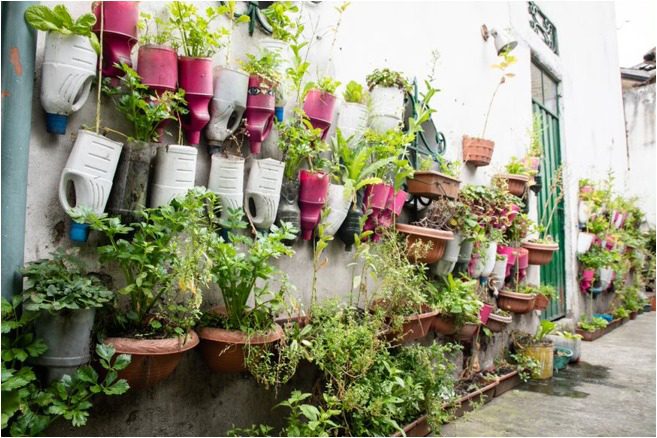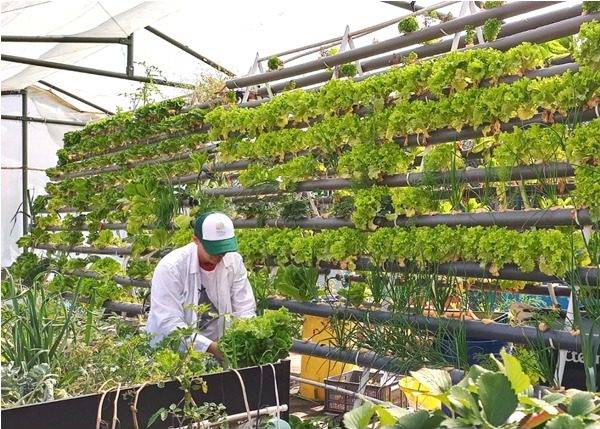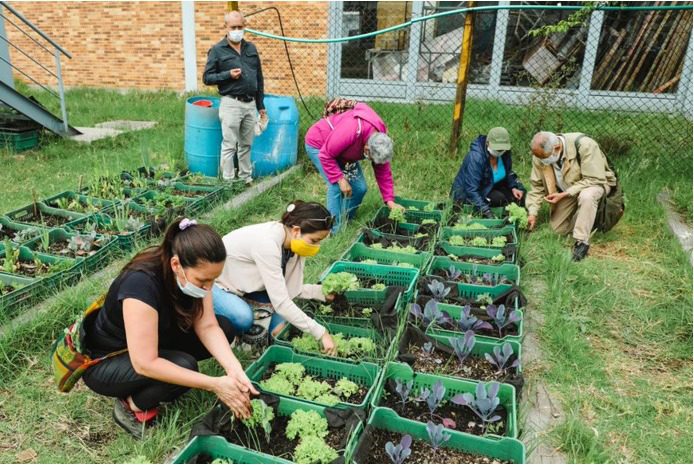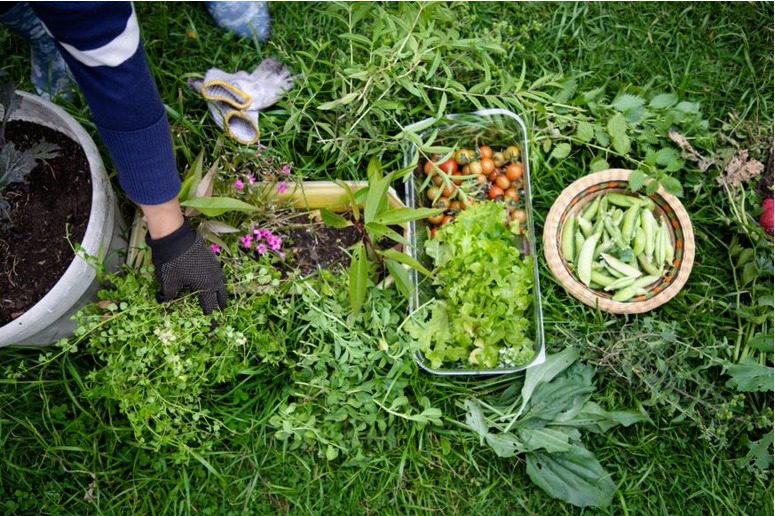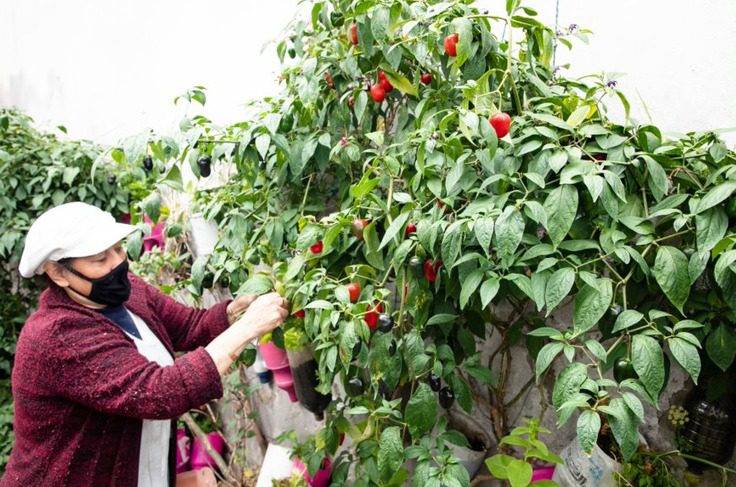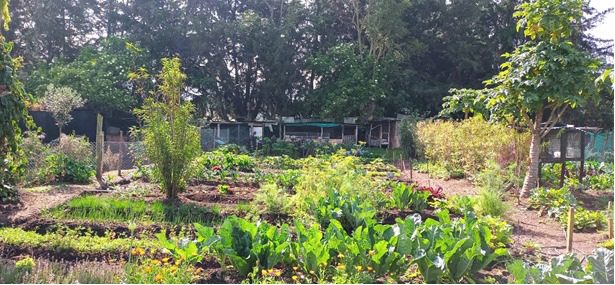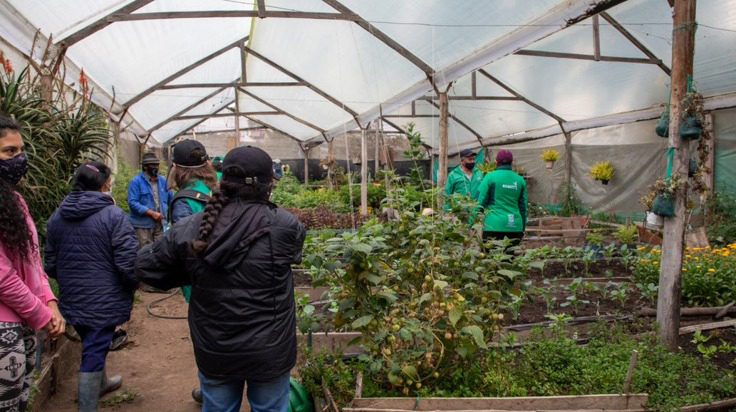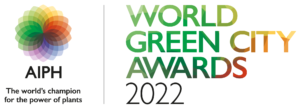Addressing the urban challenge
Breadth of the issue – How are the problem(s) that are being tackled by your initiative affecting citizens/local businesses or a significant component of the local wildlife?
As the capital of the country, Bogotá concentrates multiple social, economic and cultural factors that impact the quality of life of its inhabitants, in addition to climate change and the crisis generated by the Covid 19 pandemic, whose effects on health physical and mental of people are well known.
In 2020, the City Council declared the climate emergency, as a mechanism to promote actions that mitigate its consequences, and, around this decision, institutional and community actions were undertaken with the same purpose.
With the certainty that the health emergency would last indefinitely, communities and public and private entities took on the task of undertaking collective benefit actions, including the creation of urban vegetable gardens, not only for their ability to produce fresh food and healthy, but also for the rescue of knowledge, the generation and strengthening of the social fabric, the opportunity to rediscover ancestral and peasant knowledge, as well as to incorporate nature friendly techniques, and preserve and promote native nutritional and medicinal species and seeds.
Urban agriculture has contributed to the solution of problems of food insecurity, by cultivating, with the technical support of the Botanical Garden, more than 120 species with nutritional value, which implies having access to food from the perspective of food citizenship, axis of the public food and nutrition security policy of the city.
Depth of the issue – How seriously are the problems being tackled by your initiative impacting the life of the citizens/businesses/wildlife concerned?
The food insecurity crisis that the city has experienced with the pandemics has caused part of the population to consume less than three meals a day, which has led to health problems in the most vulnerable groups. In addition, the lack of healthy food consumption limits the good physical and mental development of the youngest, affecting women and older adults in the same way.
Air quality is affected by the pollution suffered by the city, which requires an increase in plant cover and the use of self-sustaining practices that help mitigate the negative impact on urban ecosystems and on the fauna present in the different microclimates of Bogotá, D.C.
Likewise, the contamination of water sources caused by the poor disposal of waste and the use of chemical synthesis products, the loss of soil resources due to mining and construction material extraction practices lead to climate variability due to increased production of polluting gasses.
Abandoned spaces or lots in some areas of the city have become points of insecurity where different forms of violence and crime converge.
The sum of these difficulties has generated social, environmental, economic and health problems, which make urban and peri-urban agriculture an opportunity for social fabric mending and the recovery of public use spaces.
The power of plants and natural ecosystems to deliver benefits
How is the initiative shaped by scientific evidence of the potential for plants and natural ecosystems to deliver benefits?
As a scientific research center, the Botanical Garden contributes to the urban agriculture project the generation of technical and scientific knowledge, through lines of work that include social, environmental, economic and research components.
In addition to the 120 species of common use identified in local orchards, on which technological packages are being generated, native species are being incorporated, such as amaranth and various varieties of potato, among others, with production potential, which have meanings and interactions with the species of the ecosystems.
The research center starts from the conservation of biodiversity and the promotion of biological interactions to generate systems that, in addition to being productive, are resilient to climate change, rainfall, as well as the appearance of diseases and pests.
Since this urban agriculture program has an agroecological approach, a synergy is sought between all the components of the ecosystem. In other words, it is a model that enhances the nitrogen and carbon cycles by having several plants in the same space and allowing them to coexist with different living beings and with human beings
This approach is complemented by the launch of the Nature and Health research line, in order to delve into the therapeutic potential of nature in humans, through conscious immersions in nature and hortitherapy, given the extensive existing scientific and ancestral evidence.
How has the city exploited the potential of plants and associated ecosystems to deliver more than one benefit?
Recognizing the nutritional potential of fruit trees, vegetables, legumes, cereals, roots, grains and tubers, among others, as well as seeking different ways to transform them, has allowed urban farmers not only to use what they produce for their own consumption, but also to generate an economic income. For example, transforming plants so that they can last longer gives added value in relation to fresh plants, which, being perishable, have very short marketing time.
The recovery, planting, harvesting and conservation, through agroecological practices that are carried out in the vegetable gardens, contribute to their self-sustainability. By generating compost and organic fertilizers, the production of garbage in the garden is minimized. The waste is reincorporated into the system through practices such as composting and vermiculture, in addition to the reuse of materials such as containers for planting short-cycle species.
It has also been possible to recover and innovate in food preservation and preparation techniques. Farmers are presented with various forms of culinary preparation, thereby generating a taste for the consumption of traditional and healthier foods, which had been stopped being consumed.
The rescue of knowledge, traditions, and experiences through the planting of promising native species such as potatoes, has achieved that these are promoted through the realization of the “Potato Festival” where the appropriation of the knowledge obtained through of the preparation of peasant, indigenous dishes, and renowned chefs in the country.
Innovative and Collaborative Solution
How does the initiative show evidence of feasibility, including on-going financial and logistical support?
The planned investment in the project to Strengthen Urban and Peri-urban Agriculture is COP $15,400,millions COP (4 Million USD approx) for the deployment of actions in the localities and to optimize the vegetable gardens and agricultural systems already implemented.
In this sense, progress is being made in the marketing strategy for urban farmers’ surplus crops through days called agroecological farmers’ markets, which are activated the first weekend of each month at the Botanical Garden facilities, where support is given to to farmers with technical assistance in practices such as association and crop rotation to have production of vegetables and tubers that the farmers themselves sell in the markets and the opportunity to offer their harvest products in a logistically adequate space for that purpose at no cost and without intermediaries.
The delivery of supplies offered by the Botanical Garden includes adaptation and preparation work and transportation to the beneficiary vegetable gardens.
In this way, the Botanical Garden contributes to the improvement of the conditions of urban gardens, promotes social and community organization, the social appropriation of these spaces and their sustainability.
The Bogotá Botanical Garden has as its goal the attention of 80 thousand people in the present four-year period with the resources destined for the development of this Program.
In what ways is the initiative innovative?
The main innovation in research is the review of the nutritional potential of fruit trees, vegetables, legumes, cereals, roots, grains and tubers and the search for transformation processes of these plants.
The objective is that urban farmers can take advantage of them for domestic consumption but also for sale, since the value and duration of the processed harvest products is greater, for which they can generate surpluses that make their activity more profitable.
Within the promotion of the practice, it has been possible to recover and innovate in conservation and food preparation techniques, where farmers are presented with various forms of preparation, with which it has been possible to generate a taste for the consumption of healthy and traditional foods that they had stopped consuming, due to the lack of knowledge and appropriation of the diversity of products that are generated at the national level, and that are adapted to the bioclimatic conditions of Bogotá.
In addition, the rescue of knowledge, traditions and experiences is contemplated, since the orchards are self-sustaining spaces that promote practices such as composting and vermiculture and allow the generation of organic fertilizers and fertilizers.
Taking advantage of the fact that Colombian popular culture is deeply linked to potato consumption, the promotion of native potato cultivation is proposed, for which the urban agriculture initiative includes spaces for participation and appropriation of knowledge, that is expressed in the preparation of gastronomic dishes, recipes and samples around this product.
How is the initiative supported by collaborative working across disciplines and sectors?
The practice of agriculture brings together experiences, different types of knowledge, through the participation in interdisciplinary groups, applying their technical and scientific knowledge in the activities that take place in the vegetable garden in order to improve technical conditions for increasing production, and maintaining quality and healthiness in the products of the garden.
Due to the crisis generated by the Covid 19 pandemic, in the city of Bogotá the urban agriculture practice increased considerably, as a food self-sufficiency alternative; especially in home and community gardens, with the participation of people of different ages and population groups.
As of 2020, requests from family, community and individuals groups seeking to learn or expand their knowledge about the practice of urban agriculture increased; From the second half of 2020 to February 2022, the entity has trained 14,266 people from different locations in Bogotá in basic urban agriculture and specialized topics.
Likewise, from the second half of 2020 to date, technical assistance and transfers of techniques and technologies have been made to 31,926 people linked to home, community, school, and institutional gardens. In addition, with the aim of increasing production, the Botanical Garden has delivered supplies to 11,970 vegetable gardens and has been supporting the processes established in the public space through the Protocol for Urban and Peri-urban Agroecological Agriculture in Public Space.
How does the initiative demonstrate evidence of community support?
With the interventions carried out in the different localities of Bogotá, it is evident that the gardens have become places of community organization and work, where collective thought and interaction result in processes with incidental participation in the construction of plans and public policies; as is the case of the collective construction of the Protocol for Urban and Peri-urban Agroecological Agriculture and the District Program for Urban and Peri-urban Agriculture, where community-based organizations converge and collective work ideas are deployed and reported, seeking to strengthen these processes and increase the support of the institutions.
With the urban agriculture program, activities have been coordinated between public institutions, training and higher education centres, and social organizations, which contribute to the strengthening of the social fabric in the territory.
For example, it has the support of foundations that have been organized taking food sovereignty as their main axis of work, with the implementation of home and community gardens that contribute to the family basket and generate surpluses for sale in local markets creating short channels of commercialization.
Organizations that aim to take advantage of organic waste generated from home gardens with which they produce and sell fertilizers have also joined.
Implementation, Impact and Replicability
How does the initiative demonstrate evidence of a track record of success against pursued objectives?
The young chef who wants to leave a mark with his agroecological crops:
In the Lucero Bajo neighborhood of Ciudad Bolívar, in Bogota, Brayan Rojas gave life to a garden on land that was affected by solid waste deposits. Today he sows and markets short-cycle vegetables in an agroecological way and also advises several people to build their gardens on terraces, patios and front gardens.
His first love was cooking, a romance that he started as a child. Since he has the use of reason he remembers that he watched in detail his mother, father and grandmother prepare lunches with the Andean products that cover the Cundiboyacense savannah, such as potatoes, peas, onions and corn.
He dreamed of becoming a chef to replicate the dishes made by his father, a police officer with a strong temperament and a passion for cooking. He also wanted to capture, in these culinary preparations, the love for the land that his grandparents and one of his aunts instilled in him, in the coffee plantations they had in the countryside, where he learned to cultivate.
After studying a professional technician in gastronomy, he worked in several restaurants in the capital, where he strengthened his culinary knowledge and began to experiment with various products, especially agroecological vegetables. His mission in this world, says Brayan, is to reactivate that connection with the earth in citizens and create projects or initiatives that aim to mitigate global warming.
How has the initiative had a ripple effect beyond the scope of the initiative itself, thereby demonstrating a change in the city’s and/or its partners’ way of working with plants?
In order to multiply the experience and achieve a greater scope, within the framework of an agreement with the Organization of Ibero-American States, OEI, a multimedia communication strategy was designed and is being implemented, based on the characterization of the different actors, that involves pedagogical, scientific, promotional and informative publications, in order to put the generated and applied knowledge at the service of citizens.
In this context, the entity’s website incorporated the co-creation microsite “Bogotá es mi huerta”: (“Bogota is my vegetable garden”) https://bogotamihuerta.jbb.gov.co/ , as a space for dissemination, visibility and exchange of knowledge and experiences, based on information technology.
In the microsite, the scientific, technical and social information generated within the framework of the program is beginning to be made available, and due to its interactive nature, it involves the experiences of users and promotes the exchange of knowledge.
One of the most innovative strategies consisted of linking the MUJERES QUE REVERDECEN (women that green) project to the actions of the AUPA Program (Urban and peri urban agriculture), in which the Mayor’s Office of Bogotá linked around 1,000 women in a situation of vulnerability, who were trained to develop different activities related to the management of vegetal covers, urban agriculture, gardening, among others. With which it is sought to improve their living conditions and contribute to the social and environmental recovery of the City.
How have other cities expressed interest in the initiative, or what potential does it have to interest other cities and be customised to their own circumstances?
The urban and peri-urban agriculture initiative of Bogotá is not only one of the oldest in the country but also one of the most robust, framed in a Development Plan, with measurable goals and indicators and with the oversight and accompaniment of citizens.
Through the combination of technical processes and training and education, conceptual and practical tools have been generated for the communities to integrate those tools into their local knowledge.
Training processes on issues associated with the care and maintenance of plant cover, aimed at communities, schools, groups, collectives and members of public and private institutions have sought to strengthen knowledge and care practices, integrating trees, vegetable gardening, urban agriculture and ecological restoration of high Andean ecosystems.
Requests have been received from different cities both nationally and internationally, regarding training and assistance processes on issues related to the AUPA (urban and peri urban agriculture), which, given the circumstances of the pandemic and the opportunities generated by virtuality, are being channeled and executed through the botanical garden Facebook Live:
https://web.facebook.com/JardinBotanicoDeBogota/photos/a.685181928216511/4974003616000966/
and other virtual platforms. In this way we present the technical guidelines and experiences obtained.
In terms of communication, a multimedia strategy is being implemented, based on a map of audiences, which involves educational, scientific, promotional and informative publications, in order to put the generated and applied knowledge at the service of citizens. A microsite focused on the AUPA program was made available on the entity’s website.
Sustainability and Resilience
What efforts have been made to reduce the carbon footprint of the initiative?
The pragmatic efforts of “Reverdecer Bogotá” regarding the activities of urban and peri-urban agroecological agriculture in the face of the carbon footprint, are mainly focused on self-consumption or self-sufficiency of food and its commercialization.
The agricultural practices in the urbanized areas of Bogotá allow the access of the products in a close way directly from the urban or peri-urban garden to the market, without the need for the food to travel long distances from the rurality, considering the implications regarding resources consumption.
Likewise, the agroecological management of food from urban and peri-urban agriculture contemplates energy efficient actions such as, among others, making fertilizers through composting and vermiculture, collecting and storing rainwater, using plant extracts for pest management, and not using synthetic chemicals.
The pragmatic efforts to “Green Bogotá” from the activities of urban and peri-urban agroecological agriculture in terms of carbon footprint, focus on self-consumption or self-supply of food and its commercialization.
The agricultural practices in the urbanized areas of Bogotá allow the access of the products directly from the urban or peri-urban garden to the market without the need for the food to travel long distances from the rural area, which translates into a both economic and energetic economy of resources.
Likewise, the agroecological management of food from urban and peri-urban agriculture includes energy efficiency actions such as making fertilizers through composting and vermiculture, collecting and storing rainwater, the use of plant extracts for pest management and the no use of synthetic chemicals, among others.
How have the anticipated impacts of climate change been considered?
To promote resilience to climate change, the main option is the incorporation of the agroecological approach, which is manifested in the following actions: diversification of urban gardens, incorporating new species and, in particular, promoting native species. The latter have a greater capacity to adapt to local climatic variability. Also, within the new investigated species there are some rustic ones that do not present diseases in our context (ex: Mizuna, Red Mustard).
This practice incorporates the use of local resources, such as rainwater for irrigation; the use of organic compost from the proper management of local organic waste, the rescue of native species and the strengthening of local seed banks that promote the maintenance of agrobiodiversity.
What processes does the initiative include for it to be considerate in its use of soils and other natural resources?
The activities of urban and peri-urban agroecological agriculture have been held in the social environment, considering that the community fabric through the cultural appropriation of agricultural practices is the best strategy for its sustainability over time. Without interested community groups and organizations, urban and peri-urban agriculture simply could not be implemented or carried out in Bogotá.
Agriculture in urban and peri-urban areas with agroecological management in the city is understood as a process of food sovereignty that different population groups appropriate as a lifestyle.
This includes environmentally friendly practices, use of waste, reuse of resources such as water, application of ancient techniques to control pests and diseases to replace chemicals and products with a high impact on soil and vegetation.
Urban agriculture in Bogotá is a two-way educational process, in which communities and the Botanical Garden share experiences, transfer knowledge and contribute to generating co-responsibility processes around the city’s green spaces.
Some of the goals:
- Strengthen 20,000 urban and peri-urban vegetable gardens with the supply of seeds, inputs and/or basic tools, including the creation of community seed banks for productive improvement.
- Assist 40,000 people technically and/or with technology transfer for their respective production.
- Train 20,000 people in agroecological techniques and technologies for the production and promotion of healthy and safe food consumption.
- Design and implement 1 promotion and marketing strategy with farmers’ markets.
Monitoring, Maintenance, and Management
How has the initiative been designed and implemented so that long-term needs for management and maintenance are reduced and can be met?
The urban and peri-urban agroecological (AUPA) activities of “Reverdecer Bogotá” (Bogota’s greening) have been raised from the social environment, considering that the community fabric through the cultural appropriation of agroecological practices is the best strategy for sustainability over time. Without the interested community groups and organizations, the AUPA simply could not be implemented or carried out in Bogotá.
Horticulture in urban and peri-urban areas with agroecological management contributes to food sovereignty, which the different population groups appropriate as a lifestyle, which enhances food production, environmental management, adaptation mechanisms to climate change and conservation. of biodiversity.
What protocols are in place to facilitate monitoring of results?
To measure the results of the urban agriculture program in terms of technical assistance, support visits are made to vegetable gardens, where it is verified that the communities comply with the guidelines defined from the Botanical Garden and receive advice and support.
With the training processes, participants are invited to implement their gardens and receive technical support, the knowledge acquired is evidenced and other more specialized topics are offered in order to increase opportunities and new agroecological ventures.
These goals are monitored monthly and their results are reported in the Botanical Garden monitoring system, which in turn is linked to the indicator platform of the Bogotá District Planning Secretariat.
There is also a co-creation platform called Bogotá es Mi Huerta, a microsite directed and fed by interest groups identified in the program, that is, urban farmers, through which successful experiences are made visible along with windows of opportunities for the community to transfer and acquire knowledge and experience.
This is supported by pedagogical, scientific, promotional and informative publications in order to put the generated and applied knowledge at the service of citizens.
In April 2022, the urban agriculture cell phone App will be enabled, with real-time information on the results of the project in all its variables, as a transparency tool that makes timely, updated information available to citizens for decision-making.
How has the initiative been enhanced in response to monitoring of results?
Since 2020, based on the manifest need to generate food security, compliance with the strategic lines of the District Development Plan 2020-2024, and following the diagnosis and monitoring of urban agriculture in the district, the low structuring of this line of action was detected. Therefore, an agreement has been generated with the Organization of Ibero-American States, OEI, in order to design and formulate the Agroecological Urban and Peri-urban Agriculture Program of the Capital District.
Additionally, and in parallel, a concrete response is given to community requests related to technical assistance and delivery of supplies to urban farmers, strengthening more than 5,800 urban and peri-urban vegetable gardens in just one year and approximately eight months, an action that has not been running in the city since the second half of 2008, that is, 12 years ago.
Another aspect of improvement is the development of a mobile application (App) for AUPA ( acronym for urban and peri urban agriculture ) in Bogotá D.C. which allows loading and updating information, in real time, on characterization, training processes and technical assistance; marketing actions, agroecological routes and monitoring of the gardens, as well as their respective georeferencing, data that will be integrated into the entity’s geographic information system and the “Bogotá es mi huerta”( bogota is my vegetable garden) microsite.
Urban and Peri-urban Agriculture Protocol document was formulated in a participatory manner with the entities that administer the public space and the community interested in the practices.

















